Franqui62
Rough_Rock
- Joined
- Jun 16, 2021
- Messages
- 52
grading report number?
or
all the info from the report please.
yes..angles and % from the diagram.What do you need? Angles, widths?
flat top 60-60 style stone bright but a bit lifeless with 59t 32.5 crown angle.
flat top 60-60 style stone bright but a bit lifeless with 59t 32.5 crown angle.
Anyone know if this is this an established independent grading lab, or an in-house grading system?
This is all I could find in regards to the nomenclature used:
Excellent Diamonds Ltd
www.excellentdiamonds.com.hk
So an older cut stone?
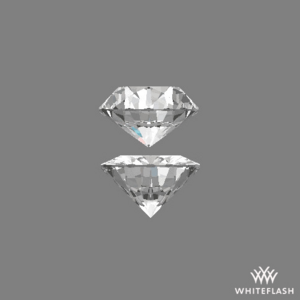
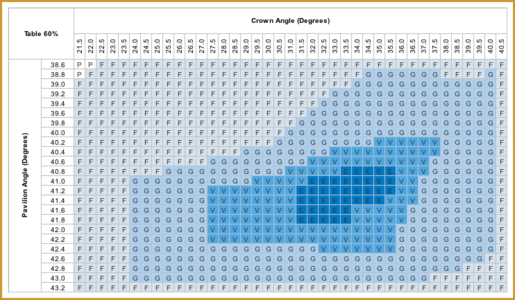


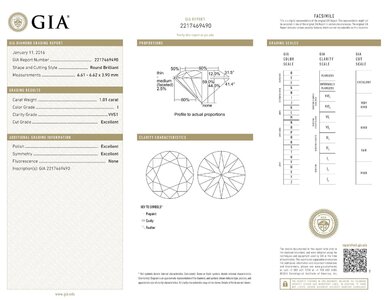

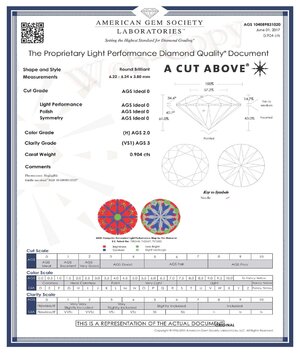
In 1919, Marcel Tolkowsky proved to the world that a stone with 53% table, 59.3% depth, 16.2% crown height, 34.5 crown and 40.75 pavilion was the true ideal cut. Later, we would learn there has to be some accounting for girdle thickness which slightly alters the "perfect" table & depth. While Tolk gets credited for the discovery, Henry Morse had actually been doing similar things since 1860.
https://www.pricescope.com/wiki/diamonds/tolkowsky-ideal-cut-diamond
I am not really certain the exact date the term "60/60" was born, but it is used to identify a stone where the table and depth both equal 60%, or thereabouts. Early myth was that those two proportions resulted in the perfect diamond. But that simply isn't true. A round diamond is not defined by only two proportions, but rather the harmony of all the proportions working in effect with one another. So it is possible to have studs or duds that would be classified as 60/60's. However, the range for studs to exist are pretty limited as noted below in the proportion charts.
https://www.whiteflash.com/diamond-education/60-60-diamonds
Examples of poorly proportioned stones that are BOTH considered 60/60's:

GIA grade proportion charts for stones with 60% tables. Notice how few hit the excellent (EX) grade criteria?

Similar proportions chart from AGS for 60% tables. The red indicates AGS' best cut grade, 0 or ideal. This is even considerably less than GIA's EX.

This entire article is a worthwhile read, but I will pinpoint the video comparisons as it directly compares a 60/60 stone, similar to the proportions you listed against a Tolk style ideal cut stone.
Generally speaking, most people are drawn to fire (rainbow light) over white light return. There are select situations like pendants or earrings where white light return may be preferred. But for e-rings, most prefer the most fire.
https://www.whiteflash.com/diamond-education/diamond-fire
This first video is recorded at 24 frames/second. The AGS Tolk cut is on the left and the GIA 60/60 is on the right.
This is the same video, but slowed down to 2 frames/second to further help identify slight angle changes and differences in performance. Again, AGS Tolk on the left and GIA 60/60 on the right.
If you have time to dive deeper, I would suggest reading the following thread. In particular there is reference to a re-cut that Brian Gavin did (of Brian Gavin Diamonds, aka BGD) for a PS member. She was very happy with the results, but I think the thread overall confirms what I mentioned above -- 60/60 doesn't inherently mean good or bad, it depends on all the other proportions that work in unison with those two select proportions that either make or break the stone.
60:60 vs Ideal MRB proportions – Is beauty in the eye of the beholder? Can one cut fit all?
Alright folks, after the 60:60 vs. “Ideal” MRB proportions topic has emerged on multiple occasions in recent PS discussions, it is finally time for the topic to have a thread of its own! I am certain that many members of the forum and members of the trade have much more experience and can...www.pricescope.com
Here are the lab reports on both stones used in the videos.
GIA Stone:


AGS Stone:


In 1919, Marcel Tolkowsky proved to the world that a stone with 53% table, 59.3% depth, 16.2% crown height, 34.5 crown and 40.75 pavilion was the true ideal cut. Later, we would learn there has to be some accounting for girdle thickness which slightly alters the "perfect" table & depth. While Tolk gets credited for the discovery, Henry Morse had actually been doing similar things since 1860.
https://www.pricescope.com/wiki/diamonds/tolkowsky-ideal-cut-diamond
I am not really certain the exact date the term "60/60" was born, but it is used to identify a stone where the table and depth both equal 60%, or thereabouts. Early myth was that those two proportions resulted in the perfect diamond. But that simply isn't true. A round diamond is not defined by only two proportions, but rather the harmony of all the proportions working in effect with one another. So it is possible to have studs or duds that would be classified as 60/60's. However, the range for studs to exist are pretty limited as noted below in the proportion charts.
https://www.whiteflash.com/diamond-education/60-60-diamonds
Examples of poorly proportioned stones that are BOTH considered 60/60's:

GIA grade proportion charts for stones with 60% tables. Notice how few hit the excellent (EX) grade criteria?

Similar proportions chart from AGS for 60% tables. The red indicates AGS' best cut grade, 0 or ideal. This is even considerably less than GIA's EX.

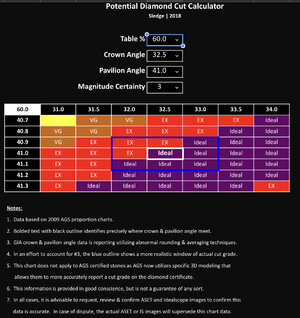
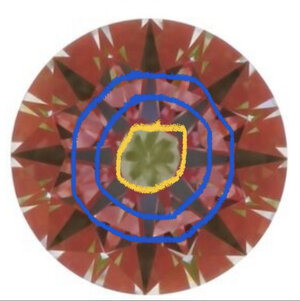
In my opinion, it's way more effort to find a well-performing 60/60 cut than a super ideal cut.
Here's a video by JannPaul showing the severe light performance limitations of a big spread 60/60 cut (they are shills for the ASET, so ignore their negative remarks about the IS...both are equally important to have in order to properly vet and scrutinize any diamond):
This entire article is a worthwhile read, but I will pinpoint the video comparisons as it directly compares a 60/60 stone, similar to the proportions you listed against a Tolk style ideal cut stone.
Generally speaking, most people are drawn to fire (rainbow light) over white light return. There are select situations like pendants or earrings where white light return may be preferred. But for e-rings, most prefer the most fire.
https://www.whiteflash.com/diamond-education/diamond-fire
This first video is recorded at 24 frames/second. The AGS Tolk cut is on the left and the GIA 60/60 is on the right.
This is the same video, but slowed down to 2 frames/second to further help identify slight angle changes and differences in performance. Again, AGS Tolk on the left and GIA 60/60 on the right.
If you have time to dive deeper, I would suggest reading the following thread. In particular there is reference to a re-cut that Brian Gavin did (of Brian Gavin Diamonds, aka BGD) for a PS member. She was very happy with the results, but I think the thread overall confirms what I mentioned above -- 60/60 doesn't inherently mean good or bad, it depends on all the other proportions that work in unison with those two select proportions that either make or break the stone.
60:60 vs Ideal MRB proportions – Is beauty in the eye of the beholder? Can one cut fit all?
Alright folks, after the 60:60 vs. “Ideal” MRB proportions topic has emerged on multiple occasions in recent PS discussions, it is finally time for the topic to have a thread of its own! I am certain that many members of the forum and members of the trade have much more experience and can...www.pricescope.com
Here are the lab reports on both stones used in the videos.
GIA Stone:


AGS Stone:


You have to take proportions with a grain of salt.
Remember a round diamond has 8 actual crown and 8 actual pavilion facets. On lab reports they get shown as ONE single value. Each lab handles the process a little different but GIA averages all 8 and then rounds to the nearest 0.5 degree for crown and nearest 0.2 degrees for pavilion.
This gross rounding effectively gives us a ballpark range. Consequently when you push the fringe and have no other data available you take on more potential risk.
Based on the proportions alone it does appear GIA shows this in EX territory. But GIA is loose. In the 2004 AGS chart I posted from WF’s website, I show the 32.5/41 combo to be teter-tottering between AGS1 and AGS2.
However the updated 2008 AGS charts show this to be in ideal range (AGS0). Using a calculator I built based on the later proportions you can see there is a white box that shows the precise intersection point. The blue box spans 1+ and 1- in each direction to create a larger range of where the actuals may fall without the rounding and averaging.

When I try to balance the light green in the table reflection (yellow) with the lighter colors in the red ring (blue donut) of your ASET, it appears to even out for the most part. There might be some lighter areas sporadically located throughout but overall appears pretty decent. It’s harder to judge with the green table reflection as a base, as opposed to red.
That said, the ASET shows us light return. It doesn’t assure us it’s white or rainbow light that we will see. Also it doesn’t mean we will find the look of the larger table appealing from a face up and/or profile view.
My concern for you is that if used for an e-ring it may not be as firey as you may expect. But my concern is based on my own bias that more fire is better.

Thank you. That’s very helpful.
I already know I am very sensitive to colour. Hence I have steered towards D,E,F stones, as I prefer lighter. For others, this is a good article with a colour test. I scored 0.
How Well Can You See Diamond Color Differences? (With Video)
People often get too hung up about diamond color grades. Here's a color test and a real life video comparison. Find out if you can see differences here...beyond4cs.com
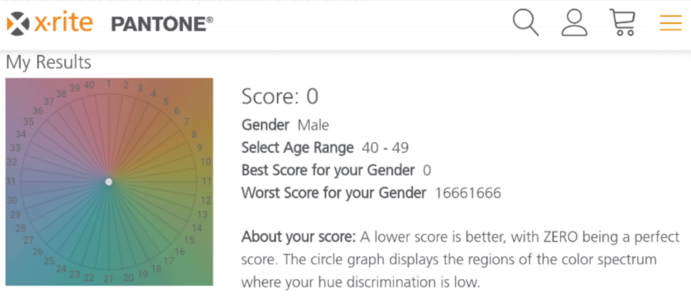
Marketing video to promote their H&A diamonds. They picked a 60/60 with a very steep pavilion with leakage.
You really need to be careful with their videos.
Thank you. That’s very helpful.
I already know I am very sensitive to colour. Hence I have steered towards D,E,F stones, as I prefer lighter. For others, this is a good article with a colour test. I scored 0.
How Well Can You See Diamond Color Differences? (With Video)
People often get too hung up about diamond color grades. Here's a color test and a real life video comparison. Find out if you can see differences here...beyond4cs.com
Am I interpreting correctly that you believe your color sensitivity prefers white light return to rainbow light return because too much rainbow light would make you feel the stone is not white enough?